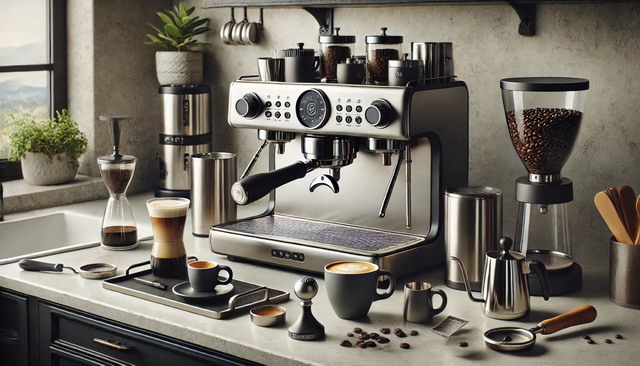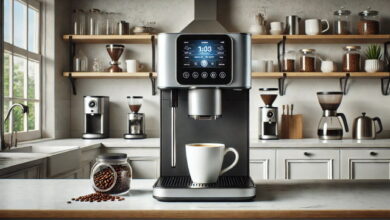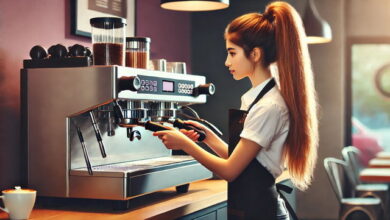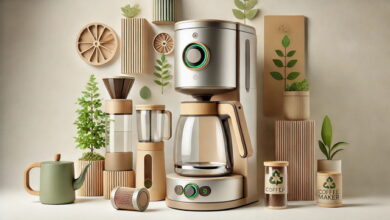Accessories for an Espresso Machine: Essential Additions for Perfect Brews
Accessories for an Espresso Machine
When it comes to making the perfect espresso, the right accessories can elevate the experience significantly. Investing in high-quality tools and add-ons not only enhances the brewing process but also ensures a consistent café-quality result at home. From milk frothers to precise measuring tools, every accessory plays a role in crafting the perfect cup.
Espresso enthusiasts often overlook the importance of maintenance and customization options available for their machines. Utilizing appropriate cleaning tools and fitting upgrades can extend the life of an espresso machine while enhancing its performance. It’s essential for users to consider their specific needs and preferences to create their ideal espresso setup.
With a wide range of accessories available, understanding which tools can make a difference in daily brewing can save time and improve quality. Exploring these options will not only enhance the espresso experience but also allow for creativity and personalization in coffee making.
Key Takeaways
- Quality accessories improve espresso brewing and maintenance.
- Essential tools enhance precision and creativity in coffee preparation.
- Proper equipment fosters a better overall coffee enjoyment experience.
Essential Accessories for Espresso Machines
To enhance the brewing experience and achieve optimal results, certain accessories are essential for an espresso machine. These tools enable precise preparation and maintenance, ensuring a great espresso shot every time.
Portafilter
The portafilter is a crucial component of an espresso machine. It holds the coffee grounds during the brewing process. Typically made from stainless steel, it comes in various sizes, generally around 58 mm for commercial machines and smaller for home models. A well-designed portafilter allows for even extraction, which is vital for achieving the perfect espresso.
These portafilters can be single or double-spouted, accommodating different brewing preferences. A double spout is popular for serving two shots simultaneously. It’s beneficial to invest in a quality portafilter, as it impacts the consistency and flavor of the espresso.
Tamper
The tamper is an essential tool for compressing coffee grounds evenly within the portafilter. Proper tamping is critical, as it affects water flow and extraction quality. A poorly tamped coffee puck can lead to channeling, resulting in uneven extraction and undesirable flavors.
Tamper sizes vary, but a diameter around 58 mm is common for standard portafilters. Some tampers come with ergonomic handles for better grip, making the process easier. It’s important to apply consistent pressure—typically around 30 pounds of force—and ensure a level tamp for the best result.
Knock Box
A knock box is used for disposing of spent coffee grounds after brewing. This accessory helps maintain a clean workspace and simplifies the cleanup process. Typically made from durable materials, knock boxes feature a sturdy horizontal bar for knocking out puck remnants.
Available in various sizes, a good knock box can accommodate multiple pucks without overflowing. This tool is essential for baristas who brew several shots in succession. By investing in a quality knock box, one can ensure a more efficient and organized brewing station.
Maintenance Tools
Proper maintenance tools are essential for ensuring the longevity and performance of an espresso machine. Regular cleaning and upkeep help preserve flavor quality and prevent potential operational issues.
Cleaning Brush
A cleaning brush is crucial for maintaining the espresso machine’s group head and portafilters. These brushes typically have stiff bristles designed to remove coffee residues and oils effectively.
Users should select a brush that matches the size of their machine’s components for optimal results. Cleaning brushes come in various shapes, including straight or curved designs, to reach different areas easily.
Routine use of a cleaning brush can prevent blockages and ensure proper water flow during brewing. It is advised to clean the machine daily after use for the best flavor extraction in future brews.
Descaling Solution
Descaling solutions are formulated to remove mineral buildup that occurs from using hard water in espresso machines. Over time, limescale can clog essential components, leading to decreased performance and increased heating times.
Using a descaling solution periodically is vital for maintaining the efficiency of the machine. Many brands offer ready-to-use liquid solutions or powders that dissolve easily in water.
Users should follow the manufacturer’s instructions regarding dilution and frequency of application. Descaling every few months or based on water hardness will help prolong the machine’s lifespan and maintain optimal brewing conditions.
Backflush Detergent
Backflush detergent is specially designed to clean the internal components of espresso machines equipped with a three-way valve. This type of cleaning ensures that coffee oils and residues do not accumulate in the machine’s internal pathways.
Backflushing needs to be performed regularly, typically once a week, depending on usage. The detergent is usually mixed with water and run through the machine using the backflush method, which forces the solution through the system.
It is important to use a detergent specifically made for espresso machines to prevent damage. Thoroughly rinsing the machine afterward ensures no detergent residue affects the flavor of future brews.
Coffee Grinding
Coffee grinding is a crucial step in the espresso-making process. The type of grinder used and the grind size can significantly affect the flavor and quality of the espresso. Understanding the options available helps in achieving the best results.
Burr Grinder
A burr grinder is often recommended for espresso preparation. It uses two revolving abrasive surfaces to create a consistent and uniform grind size. This consistency is vital, as uneven grinds can lead to extraction issues.
There are two main types of burr grinders: flat burr grinders and conical burr grinders. Flat burrs provide a uniform grind size but can produce more heat, potentially affecting flavor. Conical burrs tend to operate cooler and reduce the risk of overheating the beans.
Choosing a burr grinder also involves considering grind settings. Many grinders offer multiple settings for different brew methods, allowing precise adjustments based on user preference. Investing in a good burr grinder pays off in the quality of espresso produced.
Grind Distribution Tool
A grind distribution tool is instrumental in ensuring even coffee distribution within the portafilter. This tool helps to eliminate clumps and air pockets, facilitating a more uniform extraction during brewing.
These tools often have a flat or rake-like design. They aid in leveling the coffee bed and creating a consistent surface, which is critical for proper water flow. Proper use can significantly impact espresso quality.
Using a grind distribution tool complements the grinding process. It ensures that each particle is evenly distributed before tamping. This step minimizes channeling, where water flows unevenly through the coffee, leading to subpar extraction.
Measurement and Weighing
Accurate measurement and weighing are essential for crafting the perfect espresso. Precision in both ingredients and timing can greatly influence the flavor and quality of the brew. Key tools for these measurements include digital scales and shot timers.
Digital Scale
A digital scale is a vital tool for measuring coffee grounds and water for espresso. Most baristas prefer scales that can measure down to 0.1 grams for precision. This is crucial because the coffee-to-water ratio significantly affects the espresso’s taste.
When selecting a scale, consider features such as:
- Capacity: Ensure it can accommodate enough ingredients for your espresso shots.
- Stability: A stable platform prevents spills and ensures accuracy.
- Tare Function: This allows the user to zero out containers before adding ingredients.
Many scales also offer a timer function, combining two essential tools in one device.
Shot Timer
A shot timer is used to measure the extraction time of espresso shots. Timing is critical, as under-extraction leads to sour flavors, and over-extraction results in bitterness.
Look for a shot timer that is easy to read and reset. Key features to consider include:
- Accuracy: A timer with at least 0.1-second precision offers the best results.
- Durability: Consider timers that can withstand spills and splashes in a busy coffee environment.
- Visibility: A clear display makes it easier to keep track, even during busy service periods.
Using both a digital scale and a shot timer can significantly enhance the espresso-making process, leading to consistently better results.
Milk Frothing Add-ons
To achieve the perfect froth for espresso drinks, using the right milk frothing tools is essential. Two critical add-ons that enhance milk frothing capabilities are the milk steaming pitcher and the thermometer. Each tool plays a specific role in creating quality milk-based beverages.
Milk Steaming Pitcher
A milk steaming pitcher is vital for anyone looking to create well-frothed milk. These pitchers come in various sizes, typically ranging from 12 ounces to 20 ounces.
Key Features:
- Material: Most pitchers are made of stainless steel, offering durability and heat retention.
- Spout Design: A pointed spout allows for precise pouring, making it easier to create latte art.
- Handle: An ergonomic handle provides a comfortable grip, facilitating control during steaming.
Using a pitcher that matches the milk volume needed for specific drinks improves efficiency. A proper size also prevents splashing and ensures even froth distribution.
Thermometer
A thermometer is essential for achieving the ideal milk temperature while frothing. It helps monitor the temperature accurately, ensuring the milk is heated to the appropriate range, typically between 150°F and 155°F.
Types to Consider:
- Dial Thermometers: Easy to read and provide accurate temperature readings.
- Digital Thermometers: Offer quick readings and often feature backlighting for visibility.
Using a thermometer can prevent overheating, which results in burnt milk. Many thermometers clip easily onto the steaming pitcher, allowing seamless milk monitoring during the frothing process. Proper temperature control contributes significantly to the texture and flavor of the final beverage.
Espresso Cups and Storage
Selecting the right espresso cups and organizing storage solutions enhances the espresso experience. Proper equipment not only improves functionality but also complements the aesthetic of the coffee-making process.
Espresso Cups
Espresso cups are essential for serving rich shots of espresso. These cups are typically smaller, ranging from 2 to 3 ounces to accommodate the concentrated beverage.
Materials used in espresso cups include:
- Ceramic: Retains heat well and adds a classic look.
- Glass: Provides a modern feel and allows visibility of the crema.
- Porcelain: Offers durability and insulation.
Choosing the right cups can also affect the drinking experience. A wide rim enhances aromas, while a thicker wall keeps the liquid warm. It’s advisable to have a range of cup sizes for various espresso styles, including traditional and macchiato.
Coffee Pod Organizer
A coffee pod organizer brings efficiency and order to coffee preparation. These organizers can be found in various styles and shapes, making them versatile for different kitchen setups.
Types of organizers include:
- Drawer Inserts: Fit conveniently in kitchen drawers, keeping pods out of sight.
- Countertop Holders: Offer easy access and come in attractive designs.
- Wall-Mounted Racks: Save counter space and add visual appeal.
It’s important to choose an organizer that suits one’s coffee pod collection. An effective system should hold a variety of pod brands and flavors while being easily accessible. Proper storage helps maintain freshness and simplifies the coffee-making process, enhancing daily routines.
Water Filtration
Proper water filtration is essential for maintaining the performance of an espresso machine. It enhances water quality, improves flavor, and extends the lifespan of the machine. A well-designed filtration system can prevent scale buildup and reduce impurities.
Water Softening Filter
A water softening filter targets minerals, particularly calcium and magnesium, that contribute to hard water. Hard water can lead to scale formation inside the espresso machine, affecting its efficiency and flavor profile.
The softening process typically uses ion exchange technology. As water passes through the filter, unwanted minerals are replaced with sodium ions.
Benefits of Water Softening Filters:
- Reduced Scale Buildup: Keeps internal components functioning optimally.
- Enhanced Flavor: Improves the extraction process for better-tasting espresso.
- Longer Equipment Life: Minimizes wear and tear on the machine.
Regular replacement of the filter is important to maintain its effectiveness. Checking specifications for compatibility with specific espresso machines ensures optimal performance.
Upgrades and Customization
Customized accessories can enhance both the functionality and aesthetics of an espresso machine. Focusing on specific upgrades can significantly improve the brewing experience.
Custom Portafilter Handles
Custom portafilter handles offer both visual appeal and improved ergonomics. They come in a variety of materials such as walnut, maple, and aluminum. Choosing a handle made from a material that feels comfortable can make a noticeable difference during the brewing process.
Users can select custom colors or patterns to match their kitchen decor. Personalization options allow for a unique touch and can reflect individual style.
When upgrading a portafilter handle, ensure compatibility with the machine’s portafilter size. Many manufacturers provide guidelines regarding dimensions, making it easier to find the right fit.
Pressure Gauges
Pressure gauges are critical for precision brewing. They provide real-time feedback on the extraction pressure during the coffee-making process. This information allows users to adjust grind size and tamping technique for optimal flavor.
There are two main types of gauges: analog and digital. Analog gauges are often easier to read at a glance. Digital gauges may offer more detailed readings and can sometimes connect to mobile apps for analytics.
Installing a pressure gauge requires careful consideration of the espresso machine’s existing system. Some machines might need specific fittings or modifications. Consulting product specifications ensures a proper installation, leading to consistent brewing results.
Barista Comfort and Convenience
Creating a comfortable workspace is essential for any barista. Accessories such as barista mats and tamping stations can greatly enhance efficiency and reduce fatigue during busy hours. Attention to detail in these areas leads to improved workflow and satisfaction.
Barista Mat
A barista mat provides a cushioned surface where baristas stand while making espresso. These mats are designed to reduce strain on the legs and back, especially during long shifts.
- Material: Most mats are made from anti-fatigue materials that promote comfort.
- Size: They come in various sizes, allowing for adequate coverage under the espresso machine and coffee station.
- Grip: A non-slip surface ensures safety, preventing slips and spills.
Choosing a quality barista mat can enhance productivity and comfort, making it a worthwhile investment for coffee enthusiasts and professionals alike.
Tamping Station
A tamping station is an organized space for espresso preparation, specifically for tamping the coffee grounds. It helps baristas achieve consistency while maintaining an efficient workflow.
- Design: Many stations feature sturdy platforms to securely hold the portafilter while tamping.
- Storage: Some models include compartments for storing tools like tamper, knock box, and brushes.
- Stability: A good tamping station has a stable base to prevent movement during use.
With a reliable tamping station, baristas can focus on precision and quality, leading to better espresso shots and an improved overall experience.
15 Best Accessories for an Espresso Machine
For coffee enthusiasts, the allure of a perfectly crafted espresso is irresistible. But achieving that ideal shot isn’t just about having a top-of-the-line espresso machine. The accessories you pair with your machine play a crucial role in the process. From grinders to tampers, each accessory contributes to the quality and consistency of your espresso. In this guide, we’ll explore the essential accessories that can help you unlock the full potential of your espresso machine.
1. Tamper
A tamper is an essential tool in espresso preparation, designed to compress or tamp the coffee grounds in the portafilter basket. The purpose of tamping is to create a uniform and level bed of coffee, which is crucial for even extraction during brewing. An uneven tamp can lead to channeling, where water finds the path of least resistance, resulting in under-extracted coffee in some areas and over-extracted coffee in others. Tampers come in various sizes and shapes, usually made from metal, wood, or plastic. The size of the tamper should match the diameter of your portafilter basket for the best results. Investing in a quality tamper can significantly improve the consistency and quality of your espresso shots.
2. Knock Box
A knock box is a container used to dispose of spent coffee pucks after brewing an espresso. It typically has a rubberized bar across the top for knocking out the used coffee grounds from the portafilter. Knock boxes are designed to be durable and easy to clean, often made from stainless steel or high-quality plastic. The convenience of a knock box lies in its ability to keep your workspace tidy by providing a dedicated place to discard coffee grounds immediately after brewing. A good knock box should have a sturdy construction to withstand repeated use and should be easy to empty and clean.
3. Milk Frothing Pitcher
A milk frothing pitcher is used to steam and froth milk for espresso-based drinks like lattes and cappuccinos. The pitcher is designed to accommodate the steam wand of the espresso machine, allowing you to create microfoam by incorporating air into the milk. The shape of the pitcher, especially the spout, is critical for pouring latte art. Stainless steel is the preferred material for milk frothing pitchers due to its durability and ability to conduct heat efficiently. Sizes typically range from 12 to 20 ounces, depending on how much milk you need to froth at one time. A well-designed pitcher allows for better control over the milk frothing process, leading to smoother, creamier milk and more consistent results.
4. Milk Thermometer
A milk thermometer is a small, handy tool that clips onto the side of the milk frothing pitcher. It measures the temperature of the milk as it heats up during the steaming process. This is important because milk that is too hot can scorch, resulting in a burnt taste, while milk that is too cool will not froth properly. The ideal temperature for steamed milk is between 150°F to 155°F (65°C to 68°C), where the milk reaches a sweet spot for both texture and flavor. A good milk thermometer provides accurate readings and helps ensure you consistently achieve the perfect milk temperature for your espresso drinks.
5. Coffee Scale
A coffee scale is a precision instrument used to measure both the coffee grounds and the water used in brewing. This is essential for achieving consistency in espresso preparation, as even slight variations in the amount of coffee or water can significantly impact the flavor of the final shot. Many coffee scales also have a built-in timer, which is useful for timing the extraction process. Accuracy and responsiveness are key features of a good coffee scale, as you want instant feedback when making small adjustments to your dosing. High-quality scales are typically digital, offering precision down to 0.1 grams, ensuring that your espresso shots are brewed to the exact specifications.
6. Distributor
A coffee distributor, also known as a leveling tool, is used to evenly distribute coffee grounds in the portafilter before tamping. This ensures that the coffee bed is flat and consistent, reducing the risk of channeling during extraction. Distributors often feature adjustable bases to match the depth of the coffee bed in the portafilter. By using a distributor, you create a more even surface for tamping, leading to better extraction and, ultimately, a more balanced and flavorful espresso. This tool is particularly useful for beginners who may struggle with achieving even distribution of coffee grounds manually.
7. Grinder
A grinder is arguably the most important accessory for any espresso machine. The grind size of the coffee is crucial for proper extraction. A burr grinder is preferred over a blade grinder because it produces a more consistent grind size. Burr grinders use two revolving abrasive surfaces (burrs) to grind the coffee, allowing for more precise control over the fineness of the grounds. The grind size can be adjusted depending on the type of coffee you’re making. For espresso, a fine grind is typically required. A good grinder is essential for extracting the best flavor from your coffee beans, making it a worthy investment for any serious coffee enthusiast.
8. Cleaning Brush
A cleaning brush is used to keep the group head of the espresso machine clean. The group head is where the water flows through the coffee grounds, and it can become clogged with coffee oils and residue over time. Regular cleaning is essential to maintain the quality of the espresso and the longevity of the machine. Brushes are designed to fit into the crevices of the group head and portafilter, removing debris that can affect the taste of the coffee. Keeping these components clean ensures that every shot of espresso is free from old coffee residues, which can impart unwanted flavors.
9. Descaler
A descaler is a chemical solution used to remove mineral deposits (limescale) from the internal components of an espresso machine. Over time, minerals from water can build up inside the machine, affecting its performance and the taste of the espresso. Descaling is a crucial maintenance step to ensure the longevity and efficiency of the espresso machine. The frequency of descaling depends on the hardness of the water used, but it is generally recommended to descale every few months. Using a descaler regularly helps maintain optimal water flow and pressure, ensuring that your espresso machine continues to produce high-quality coffee.
10. Water Filter
A water filter is used to improve the quality of the water going into the espresso machine. The quality of water can significantly impact the taste of espresso, as it makes up the majority of the final brew. Hard water, which contains high levels of calcium and magnesium, can lead to limescale buildup inside the machine and negatively affect the flavor of the coffee. A water filter removes these minerals and other impurities, ensuring that only clean, pure water is used for brewing. This not only improves the taste of the espresso but also prolongs the life of the espresso machine by reducing the need for frequent descaling.
11. Bottomless Portafilter
A bottomless portafilter, also known as a naked portafilter, is a type of portafilter without a spout, exposing the bottom of the coffee basket. This allows the barista to observe the extraction process directly, providing visual feedback on the quality of the shot. A bottomless portafilter can help diagnose issues with tamping, grind size, or distribution, as any flaws will be visible in the way the espresso flows from the basket. It’s a valuable tool for improving technique and achieving more consistent results. Additionally, using a bottomless portafilter can result in a richer crema, enhancing the flavor and texture of the espresso.
12. Dosing Funnel
A dosing funnel is an accessory that attaches to the top of the portafilter basket, making it easier to transfer coffee grounds from the grinder without spilling. This is particularly useful when using a grinder that dispenses coffee directly into the portafilter. The funnel helps guide the grounds into the basket, minimizing mess and waste. It’s especially beneficial for those who grind their coffee to order, as it ensures that all the coffee grounds make it into the portafilter. A dosing funnel also allows for more even distribution of the coffee grounds before tamping, contributing to a more consistent extraction.
13. Shot Glass with Markings
A shot glass with markings is a simple yet effective tool for measuring espresso shots. The glass typically has lines indicating the volume of liquid, such as 1 ounce or 2 ounces, making it easy to see if your espresso shot is pulling correctly. This is important for ensuring consistency, especially when dialing in the grind size or adjusting the dose. Some shot glasses are designed to withstand the high temperatures of freshly brewed espresso and may feature double-walled construction for insulation. Using a marked shot glass helps ensure that each shot of espresso is extracted to the desired volume, contributing to a more controlled and repeatable brewing process.
14. Tamper Mat
A tamper mat is a rubber or silicone mat that provides a stable surface for tamping coffee. It protects both the countertop and the portafilter from damage during the tamping process. The mat also helps prevent the portafilter from slipping, ensuring a more secure and even tamp. Tamper mats are particularly useful in busy environments where speed and efficiency are important. Some mats have raised edges or grooves to hold the portafilter in place, adding an extra level of stability. A good tamper mat is an essential accessory for anyone serious about making consistent, high-quality espresso.
15. Group Head Gasket
A group head gasket is a rubber seal that sits between the group head and the portafilter. Over time, this gasket can wear out or become hard, leading to leaks and affecting the quality of the espresso. Replacing the group head gasket is a simple yet important maintenance task that helps ensure a proper seal, preventing water from leaking during brewing. Regular replacement of the gasket keeps the machine in optimal working condition and ensures that every shot of espresso is brewed with the correct pressure. Having spare gaskets on hand is a good practice for any espresso machine owner, as it allows for quick and easy replacement when needed.
How to Choose the Best Coffee Grinder for Espresso Machines
The journey to a great espresso begins long before the water meets the coffee. It starts with the grind. A high-quality coffee grinder is arguably the most important accessory for any espresso machine. Why? Because the grind size and consistency directly affect the extraction process, which in turn influences the flavor, aroma, and overall quality of the espresso.
When choosing a coffee grinder, consider the following factors:
- Grind Consistency: A consistent grind is essential for even extraction. Burr grinders are generally preferred over blade grinders because they produce a more uniform grind size.
- Adjustability: Different espresso machines and personal preferences require different grind sizes. A grinder with multiple settings allows you to fine-tune the grind to match your machine and taste.
- Capacity: If you’re making multiple shots in a single session, a grinder with a larger capacity will save you time and effort.
For beginners, a reliable entry-level burr grinder is a great starting point. As you develop your skills, you may want to invest in a higher-end model that offers greater precision and durability.
Benefits of Using a Precision Tamper with Your Espresso Machine
Tamping is an often overlooked yet critical step in espresso preparation. The purpose of tamping is to evenly compress the coffee grounds in the portafilter, ensuring consistent resistance during extraction. If the grounds are unevenly packed, water will flow through some areas more quickly than others, leading to under-extraction or over-extraction.
A precision tamper is designed to help you achieve a perfectly level tamp every time. Here’s why it’s worth the investment:
- Consistency: A precision tamper reduces the variability in your tamping technique, leading to more consistent shots.
- Improved Extraction: Evenly packed grounds result in better extraction, enhancing the flavor and aroma of your espresso.
- Ergonomics: Many precision tampers are ergonomically designed to fit comfortably in your hand, making the tamping process easier and more enjoyable.
When choosing a tamper, consider the size of your portafilter and the weight of the tamper. A heavier tamper often provides better control, allowing for a more consistent tamp.
The Importance of a Good Espresso Machine Cleaning Kit
Maintaining your espresso machine is crucial for both the longevity of the machine and the quality of the espresso it produces. Over time, coffee oils, grounds, and mineral deposits can build up inside your machine, affecting its performance and the taste of your coffee.
A comprehensive cleaning kit typically includes:
- Cleaning Brushes: These are used to remove coffee grounds from hard-to-reach places like the group head and the portafilter.
- Descaling Solution: Mineral deposits, especially from hard water, can accumulate in your machine. A descaling solution helps dissolve these deposits, ensuring your machine operates smoothly.
- Cleaning Tablets: These are used to clean the internal components of the machine, removing coffee oils and residues that can affect flavor.
Regular cleaning not only ensures that your espresso tastes fresh and pure but also extends the life of your machine, saving you money in the long run.
How to Use a Milk Frother with an Espresso Machine for Perfect Lattes
For many, the perfect espresso is just the beginning. The ability to create lattes, cappuccinos, and other milk-based drinks elevates the experience. A milk frother is an essential tool for achieving the creamy, velvety foam that tops these beverages.
There are two main types of milk frothers: steam wands (built into many espresso machines) and standalone electric frothers. Here’s how to use each:
- Steam Wand: Fill a stainless steel pitcher with cold milk, then submerge the steam wand just below the surface. Turn on the steam and slowly lower the pitcher as the milk expands, keeping the wand near the surface to create microfoam.
- Electric Frother: These are typically easier to use. Simply pour in the milk, turn on the frother, and let it do the work. Many models have settings for different types of froth, from thick and creamy to light and airy.
Perfecting your frothing technique takes practice, but with time, you’ll be able to create beautiful, café-quality lattes at home.
Conclusion
Investing in the right accessories is key to getting the most out of your espresso machine. From a high-quality grinder to a precision tamper and a reliable cleaning kit, each tool contributes to the overall quality of your espresso. By understanding and optimizing these elements, you can elevate your coffee-making skills and enjoy a consistently exceptional espresso experience.








